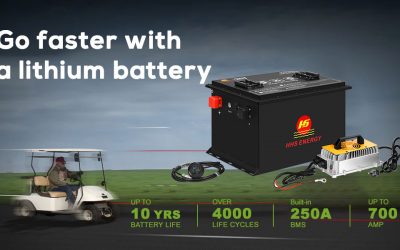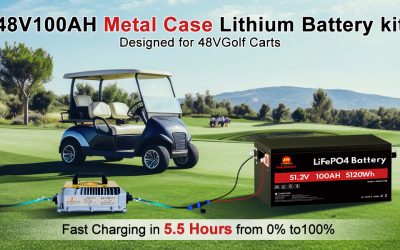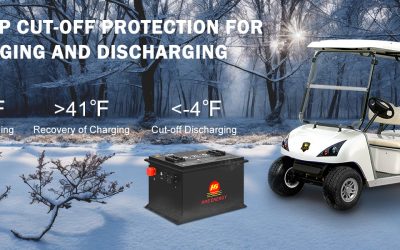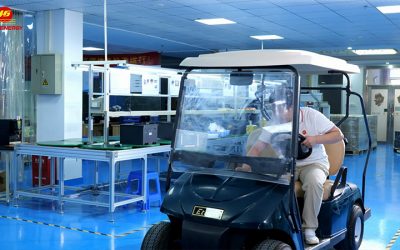HHS ENERGY 48V LiFePO₄ Battery for Golf Carts: The Smarter Power Behind Every Ride
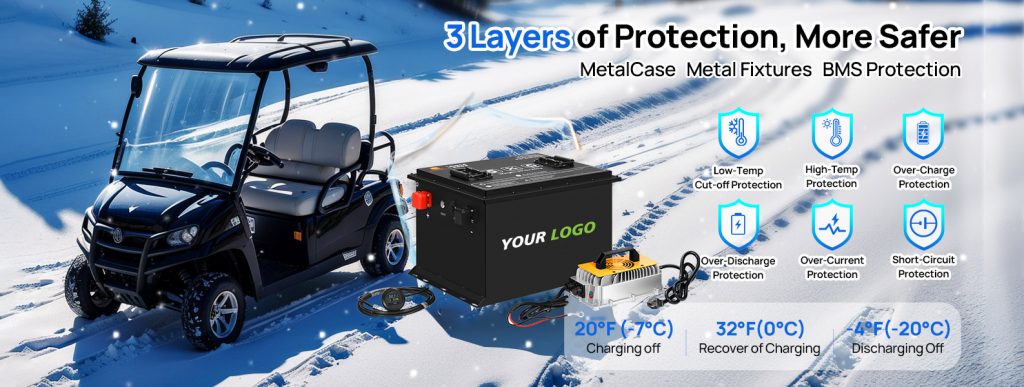
Golf carts have evolved far beyond the fairway. Whether used in gated communities, resorts, campus transport, or personal leisure, the demand for more efficient, reliable and maintenance-free power systems is stronger than ever. Enter the 48 Volt LiFePO₄ battery — and specifically the HHS ENERGY 48V LiFePO₄ pack — a game-changer in electric mobility.
In this comprehensive guide we’ll explore:
-
Why 48V systems are the sweet spot for modern golf carts
-
How LiFePO₄ chemistry outperforms traditional lead-acid batteries
-
The specific design and advantages of HHS ENERGY’s 48V pack
-
Real-world installation and performance stories
-
Selection criteria, compatibility checks, and best practices
-
Maintenance tips and long-term cost benefits
-
Future outlook for golf-cart power systems
-
FAQs and how to decide if this upgrade is right for you
Let’s dive in.
1. Why Choose a 48V System for Your Golf Cart?
Modern golf carts typically come in 36V, 48V or sometimes 72V systems — but 48V remains the industry standard for many applications. Why? Because 48V offers the best balance of performance, compatibility and cost:
-
It provides strong torque and speed while keeping current manageable (higher voltage means lower current for same power)
-
Many controllers, motors and chargers are designed around 48V systems, making upgrades simpler
-
For most recreational and utility golf-cart uses, 48V provides more than enough range and performance without the complexity of higher-voltage systems
By focusing on the 48V architecture, HHS ENERGY meets the sweet spot of upgrade value while also addressing the major weaknesses of legacy lead-acid packs.
2. Why LiFePO₄ Chemistry Outperforms Lead-Acid
Switching from traditional lead-acid batteries to lithium iron phosphate (LiFePO₄) represents a quantum leap in energy storage. The advantages are substantial:
-
Longer lifespan: While lead-acid packs usually last 300-500 cycles (or 3-5 years for golfcart use), LiFePO₄ packs often achieve 3,000-5,000 cycles or more. 红道电池+1
-
Higher usable depth: LiFePO₄ systems allow deeper discharge (often 80-100% usable) without damaging the battery, whereas lead-acid is limited to ~50% depth for longevity.
-
Weight savings: Lithium packs can weigh half (or less) of comparable lead-acid sets, improving acceleration, handling and charger efficiency. 广东普星新能源科技股份有限公司
-
Maintenance-free: No watering, no acid leaks, fewer corrosion issues — meaning less downtime and lower lifetime cost.
-
Stable voltage under load: LiFePO₄ maintains voltage during discharge far better than lead-acid, which often suffers from voltage sag and reduced performance under load. IMPROVE BATTERY
-
Eco-friendly: Less frequent replacements, fewer toxic materials, better recyclability.
All of these benefits make the 48V LiFePO₄ battery a smart upgrade for any serious golf-cart user — and HHS ENERGY targets exactly that.
3. Meet the HHS ENERGY 48V LiFePO₄ Battery Pack
HHS ENERGY’s 48V LiFePO₄ battery is designed specifically for golf cart use, with features optimized for performance, reliability and install-ease. Here’s what sets it apart:
Key Specs & Features
-
Nominal Voltage: 48V (actual pack voltage ~51.2V or 58.4V depending on series)
-
Capacity options: e.g., 100Ah, 120Ah, 150Ah configurations (vary by model)
-
Cycle Life: Rated for 3,000+ cycles at 80% depth of discharge
-
Battery Management System (BMS): Integrated thermal, over-charge/over-discharge, short-circuit, cell balancing protections
-
Lightweight construction: Up to 50% lighter than equivalent lead-acid sets
-
Fast charging supported: With compatible lithium charger, full charge often in 3-4 hours
-
Plug-and-play or easy retrofit design: Install kits offered with compatible terminals, mounting kits and wiring harnesses
What You’ll Gain
-
Improved acceleration and hill-climb performance due to stable voltage and lower internal resistance
-
Longer operational range: With more usable capacity and lighter weight, the cart goes farther on a single charge
-
Less downtime: Faster charges + fewer maintenance tasks = more time driving
-
Lower lifetime cost: Fewer battery replacements, fewer maintenance tasks, more usable life
In short, HHS ENERGY’s 48V LiFePO₄ pack is more than just a battery—it’s a full upgrade in golf-cart power architecture.
4. Real‐World Installation Example
Here’s a typical step-by-step experience of a cart upgrade:
Step A. Determine Compatibility
The first step is verifying your cart’s system: make sure it is a 48V setup (usually 8× 6V or 4× 12V lead-acid battery pack). Confirm charger voltage, controller ratings, mounting space and connectors.
Step B. Remove Old Batteries
Disconnect negative terminal first, remove all lead-acid batteries (which may weigh 300 lbs+ in total), clean the tray, neutralize acid deposits if any.
Step C. Install the HHS ENERGY 48V Pack
Place the pack in the tray or dedicated bay, mount with secure brackets, connect positive and negative leads, route wiring carefully. If required, install the lithium-compatible charger.
Step D. Initial Charge & Test Drive
Charge the new pack fully with the lithium charger, then test drive. Many users report immediate improvements: smooth throttle, less lag, better hill performance.
Step E. Monitoring & Fine-Tuning
Using the built-in BMS or optional app (if available), monitor battery voltages, temperatures and health over first few cycles. Ensure wiring, connectors and charger operate as expected.
Real User Feedback
One forum user reported:
“I installed a 48V LiFePO₄ pack and saw acceleration improve and range increase significantly—on a full charge I went from ~18 miles to ~30 miles.” Reddit
Another source states that many carts with a quality 48V lithium upgrade now manage 25–40 miles per charge, depending on load and terrain. Redodo Power
5. Selection & Compatibility Checklist
Before you buy a 48V LiFePO₄ battery for your cart, use this checklist to avoid mis-match and ensure optimal performance:
-
Voltage Compatibility – Ensure system nominal voltage matches pack (48V systems).
-
Charger Compatibility – Lithium packs require proper charger profile. Lead-acid chargers may harm lithium cells.
-
Controller & Motor Rating – Verify your motor and controller can handle higher power and have wiring capacity.
-
Mounting Space & Weight – Although lithium packs are lighter, you still need correct tray fit, secure brackets, and proper ventilation.
-
Connector and Wiring Ratings – Ensure cables and terminals are rated for higher currents and low resistance.
-
Thermal Management – If your cart operates in hot or cold climates, check for BMS thermal protection and consider insulation or heating if needed.
-
Warranty & Support – Verify your supplier offers warranty, after-sales support, and clear documentation.
-
Capacity & Range Requirements – Choose Ah rating appropriate to your usage. Consider terrain, load, number of trips.
-
Monitoring & Maintenance – While lithium packs require minimal maintenance, having monitoring tools (via BMS/app) helps longevity.
HHS ENERGY covers these bases with its 48V LiFePO₄ pack and offers installations, support tools and warranty coverage.
6. Maintenance, Lifespan & Total Cost of Ownership
Maintenance
Lithium packs are almost maintenance-free. Key simple tasks:
-
Keep terminals clean
-
Monitor wiring and connections
-
Ensure charger settings match lithium profile
-
Avoid deep discharging (below ~10-20%) if trying to maximize lifespan
Lifespan
Where lead-acid systems in golf carts typically last 3-5 years, lithium systems like HHS ENERGY’s 48V packs easily reach 8-10 years or more with proper use. Continental Battery The cycle life (3,000+ cycles) means fewer replacements and less downtime.
Total Cost of Ownership
Although upfront cost may be higher than traditional lead-acid packs, the longer life, reduced maintenance and improved performance mean lower cost per mile and fewer replacements. Several sources estimate that high-quality 48V lithium batteries reduce lifetime cost by 30-50%. Redway Power™ – OEM Lithium Batteries
7. Future Outlook & Why Now Is a Good Time to Upgrade
The golf-cart industry is moving rapidly toward lithium power. Several trends are driving the shift:
-
Increased demand for lighter vehicles and longer range
-
Reduced cost of lithium battery technology
-
Stricter environmental regulations pushing away lead-acid systems
-
Better data connectivity (BMS monitoring, mobile apps)
-
Higher performance expectations from users for off-road utility vehicles
Upgrading now means you’ll stay ahead of the curve. With HHS ENERGY’s 48V LiFePO₄ pack, you’re aligning with the future of electric mobility.
8. FAQ: Your Key Questions Answered
Q: Can I directly replace a lead-acid 48V pack with a 48V LiFePO₄ pack?
A: Yes — in many cases you can. But you must ensure compatibility of charger, wiring and BMS. Some modifications may be needed.
Q: How far can my cart go with a 48V LiFePO₄?
A: Depends on capacity, terrain, load and usage. Many users report 25-40 miles or more per charge with quality packs. Redodo Power
Q: Is the charger the same as before?
A: Not always. LiFePO₄ requires a charger with correct voltage cut-off and profile. Using lead-acid charger may reduce lifespan or damage the pack.
Q: Does it make my cart faster?
A: Potentially. Because lithium packs deliver stable voltage and lower internal resistance, you may notice improved acceleration and hill climb performance.
Q: What about cold weather performance?
A: LiFePO₄ performs better than lead-acid in cold, but extreme cold charging may need battery warming or BMS support. Always check specs.
9. Summary: Why the HHS ENERGY 48V LiFePO₄ Battery Is the Smart Upgrade
If you’re tired of heavy, maintenance-heavy lead-acid packs, and you want longer range, better performance and lower hassle — the HHS ENERGY 48V LiFePO₄ battery is the smarter power behind your ride. Plug in fewer worries, charge faster, drive farther, and spend less time on battery upkeep and more time enjoying the ride.
It’s not just an upgrade—it’s a transformation in how you power your ride.
